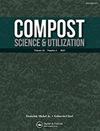Effects of Different Substrate Ratios on the Growth and Physiology of Sequoia sempervirens Container Seedlings
IF 0.9
4区 农林科学
Q3 ECOLOGY
引用次数: 3
Abstract
Abstract Container technology can effectively control soil environment and nutrient status to obtain the optimal plant growth condition. Peat, green waste compost (GWC), soil and perlite were used as substrate materials to study the effects of different substrate ratios on growth and physiology of 1.5-year-old Sequoia sempervirens container seedlings. The optimal substrate ratio of S. sempervirens container seedlings was obtained by L9 (34) orthogonal design and was finally evaluated by principal component analysis. The volume ratio of peat: GWC: soil: perlite of 4: 1.5: 1: 2 was the best substrate ratio for S. sempervirens across all parameters, whose porosity, bulk density (BD) and gas-water ratio (GWR) were within the ideal ranges. The concentrations of total nitrogen (TN) of 1.40% and total phosphorus (TP) of 0.13% were the highest among the nine different substrates. The total potassium (TK) and electrical conductivity (EC) were 0.13% and 0.70 ms cm−1, respectively. In addition, the plant height and ground diameter growing in the substrate were increased by 28% and 39% compared to their respective initial values. The content of peat and GCW had significant effects on growth (p < 0.01). The GWR in T2 (peat: GWC: soil: perlite = 6: 1: 0.5: 2) and T6 (peat: GWC: soil: perlite = 4: 0.5: 0.5: 1) are not suitable for S. sempervirens container seedlings. The PCA ranking of the 9 groups of substrates is: T8 > T1 > T4 > T3 > T2 > T5 > T7 > T9 > T6. The combination of peat, GWC, soil and perlite in an appropriate ratio could provide a good environment for S. sempervirens container seedlings.不同基质配比对红杉容器苗生长和生理的影响
摘要容器技术可以有效地控制土壤环境和养分状况,获得最佳的植物生长条件。以泥炭、绿色垃圾堆肥(GWC)、土壤和珍珠岩为基质材料,研究了不同基质配比对1.5年生红杉容器苗生长和生理的影响。采用L9(34)正交设计,确定了粗穗细辛容器苗的最佳基质配比,并用主成分分析法对其进行了评价。在所有参数下,泥炭:GWC:土壤:珍珠岩的体积比为4:1.5:1:2是S.semperverrens的最佳基质比,其孔隙率、体积密度(BD)和气水比(GWR)均在理想范围内。在9种不同基质中,总氮(TN)和总磷(TP)的浓度分别为1.40%和0.13%。总钾(TK)和电导率(EC)分别为0.13%和0.70% ms cm−1。此外,生长在基质中的株高和地径分别比其初始值增加了28%和39%。泥炭和GCW含量对生长有显著影响(p T1 > T4 > T3 > T2 > T5 > T7 > T9 > T6.泥炭、GWC、土壤和珍珠岩以适当的比例组合,可以为S.semperverrens容器苗提供良好的生长环境。
本文章由计算机程序翻译,如有差异,请以英文原文为准。
求助全文
约1分钟内获得全文
求助全文
来源期刊

Compost Science & Utilization
农林科学-生态学
CiteScore
4.10
自引率
0.00%
发文量
0
审稿时长
>36 weeks
期刊介绍:
4 issues per year
Compost Science & Utilization is currently abstracted/indexed in: CABI Agriculture & Environment Abstracts, CSA Biotechnology and Environmental Engineering Abstracts, EBSCOhost Abstracts, Elsevier Compendex and GEOBASE Abstracts, PubMed, ProQuest Science Abstracts, and Thomson Reuters Biological Abstracts and Science Citation Index
 求助内容:
求助内容: 应助结果提醒方式:
应助结果提醒方式:


